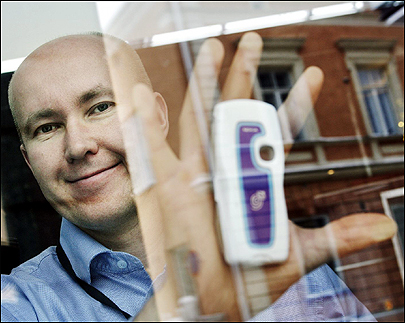The Finnish city of Oulu, together with RFID systems integrator ToP Tunniste, has begun piloting a parking system on streets and in garages that would allow drivers to pay for parking with their mobile phones. Pauli Tossavainen, the company’s managing director, says ToP Tunniste is providing its SmartParking solution, part of its SmartTouch product family, for the pilot.
Launched on Sept. 3 in Oulu’s city center, the trial involves 50 participants equipped with SmartParking mobile phones and SmartTouch parking stickers containing NXP Semiconductors‘ Mifare Ultralite 13.56 MHz chips, which comply with the ISO 14443-A standard. Pilot participants apply a SmartTouch sticker to the windshield of their car. The Nokia 6131 phones used in the trial contain a Near Field Communication (NFC) RFID module. The city attached nearly 400 location RFID tags to street lampposts, parking meters and garage gates throughout the area.

A driver parking in a space on the street taps his RFID-enabled mobile phone against the sticker, causing the phone’s NFC module to receive the windshield tag’s unique identification number. The driver then taps the phone against the nearest location sticker. The phone receives that sticker’s unique ID number, Tossavainen says, and sends both the vehicle and location numbers to the SmartTouch server hosted by ToP Tunniste, via a GPRS connection provided by TeliaSonera.
The system chronicles how long the car is in that space, and the phone sends a reminder message each hour to ensure the person does not drive away without logging out. When it’s time to depart, the driver taps the windshield sticker with the mobile phone once more, and the phone displays a message showing how long the car was parked there and how much money will be deducted from a designated bank or credit card account.
When parking at garages operated by Oulun Pysäköintitalo, the driver taps the cell phone against the garage gate. An interrogator receives the cell phone’s ID number and begins the transaction, causing the gate to open. Upon leaving the garage, the driver again taps the phone on the exit gate, ending the transaction.
The pilot includes equipping two parking-enforcement officers with NFC-enabled mobile phones. Traveling through the Oulu city center, the officers tap the phone against each windshield to receive confirmation that the car’s owner is being billed for parking time. Users can also access their parking history on a Web site hosted by ToP Tunniste, which is providing the software for phone reporting, as well as the garage gate interrogator and the back-end interface between the mobile phones and the Web.
Oulu drivers not involved in the pilot typically use cash to pay for metered parking, or credit cards at garages, says Janne Mustonen, project manager for the Oulu Innovation Environment Project. The city-run project oversees this pilot and studies mobile network opportunities to improve city services. The technology used for the trial enables drivers to forego using coins, tickets or credit cards. “An important factor for those parking their cars using the NFC solution is that a parking fee is equal to real parking time,” Mustonen explains, “which means that one doesn’t have to pay any extra for parking or worry about running out of parking time.”
Technical research firm VTT is collecting and analyzing user feedback. “People participating in the SmartParking pilot have already told us that they find it very practical and easy—as simple as a touch,” Mustonen says. “From the city’s point of view, the NFC solution allows us to provide better services, as well as receive real-time information of how people really use street and garage parking. This is essential information in order to develop the city’s parking services.”
Still, Tossavainen notes, full implementation of the SmartParking system may yet be years ahead. “There are not many NFC-enabled phones in use in Finland,” he says. Tossavainen estimates that at least half of the mobile phone users will have NFC capability within five years. In the meantime, the city hopes to examine other uses for the technology, such as allowing parking officials to monitor when and where parking is heaviest, and to send notifications to drivers via their NFC-enabled phones, leading them to the nearest empty parking space. If conducted, however, such research would take place in a separate or later phase of this pilot.

